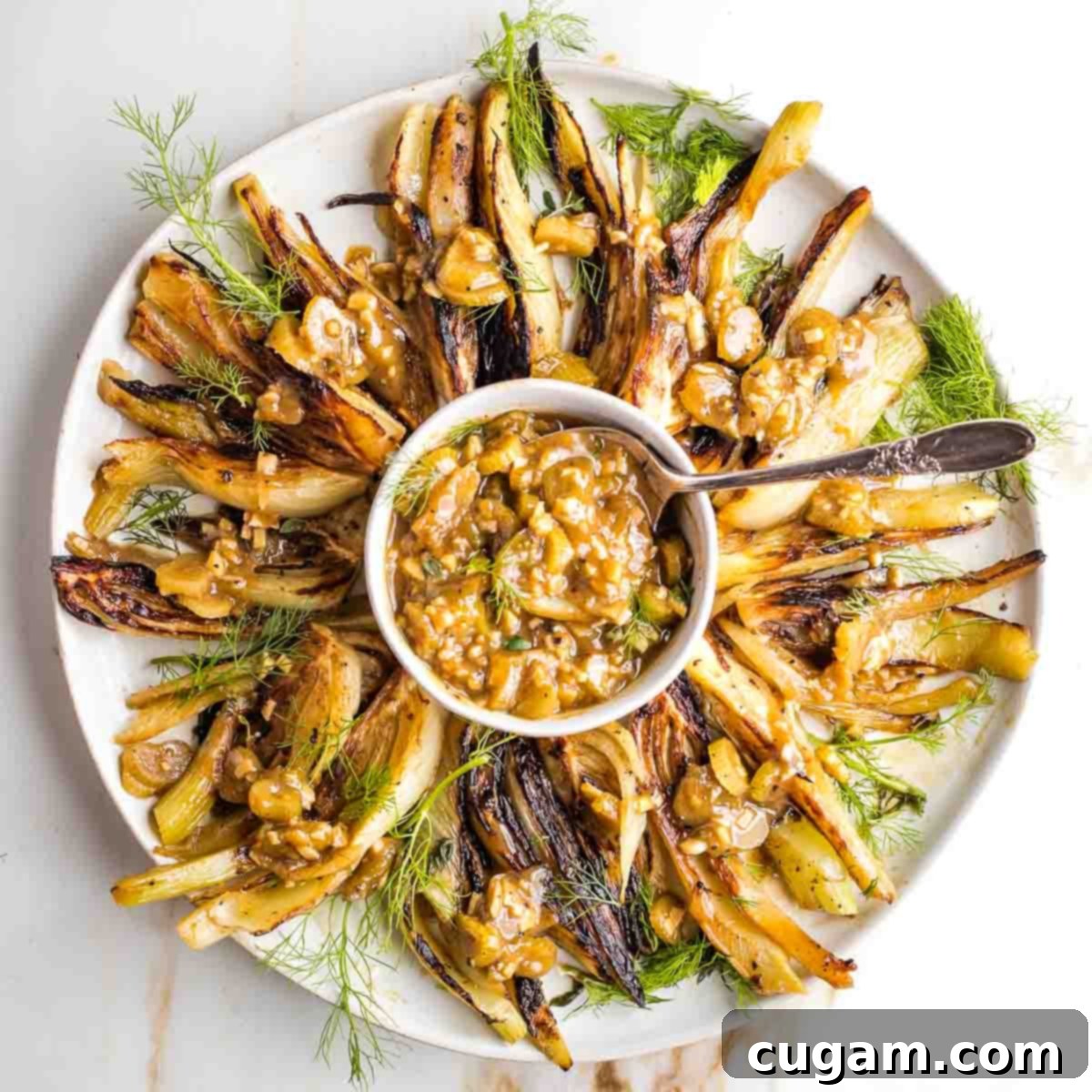Mastering Braised Fennel: The Ultimate Sweet & Tender Side Dish for Any Occasion
Discover the delightful transformation of fennel with this incredibly Easy Braised Fennel Recipe. Forget any preconceived notions about fennel’s distinct licorice-like flavor; through the magic of braising, this humble vegetable softens into a wonderfully sweet, tender, and beautifully caramelized side dish that will captivate your taste buds. Perfect for elevating a simple weeknight meal or gracing your holiday dinner table, this recipe offers an elegant and surprisingly simple way to enjoy the often-overlooked charm of fresh fennel. Braising in a flavorful vegetable broth allows the fennel’s natural sugars to develop, creating a rich depth of flavor that is both comforting and sophisticated.
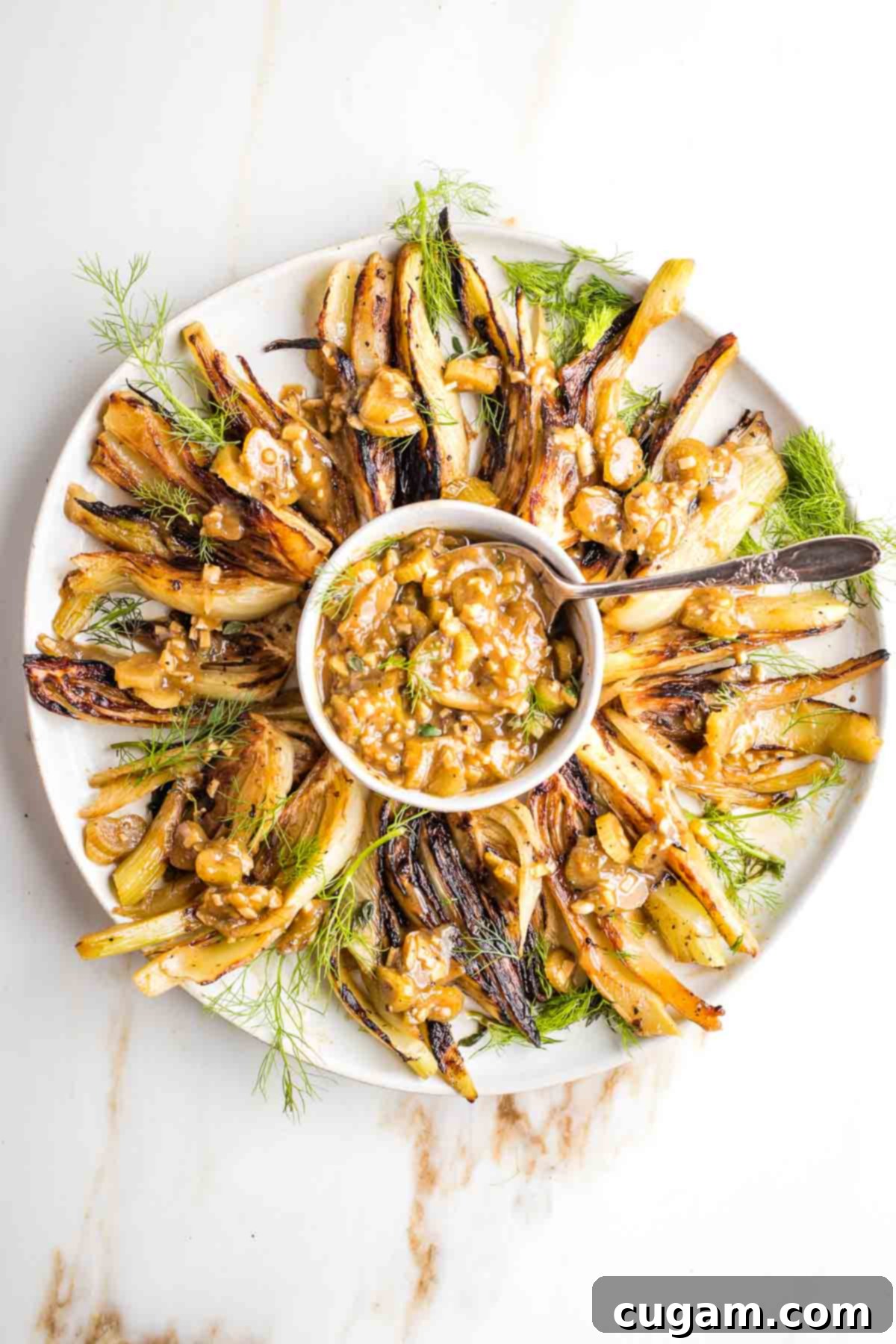
[feast_advanced_jump_to]
Braised fennel isn’t just a side dish; it’s a culinary revelation. Large, crisp fennel bulbs, when sliced into robust wedges and gently cooked on the stovetop, become an incredibly versatile and flavorful addition to any meal. This method is particularly ingenious for holidays like Thanksgiving, Christmas, or Rosh Hashanah, when precious oven space is often at a premium. By utilizing a single skillet on the stovetop, you can effortlessly prepare a stunning vegetable that offers something truly unique and delicious. Unlike more common root vegetables, fennel presents an unexpected beauty and a delicate sweetness once cooked, making it an excellent choice for impressing guests or simply adding variety to your family’s diet. Its mild, almost buttery texture and subtly sweet profile after braising make it appealing even to those who might be hesitant to try fennel. It’s a fantastic way to introduce a new vegetable to your repertoire, promising a beautiful and delicious outcome every time. Beyond its fantastic flavor, fennel is also packed with essential nutrients, including Vitamin C, dietary fiber, and potassium, offering a healthy boost to your meals.
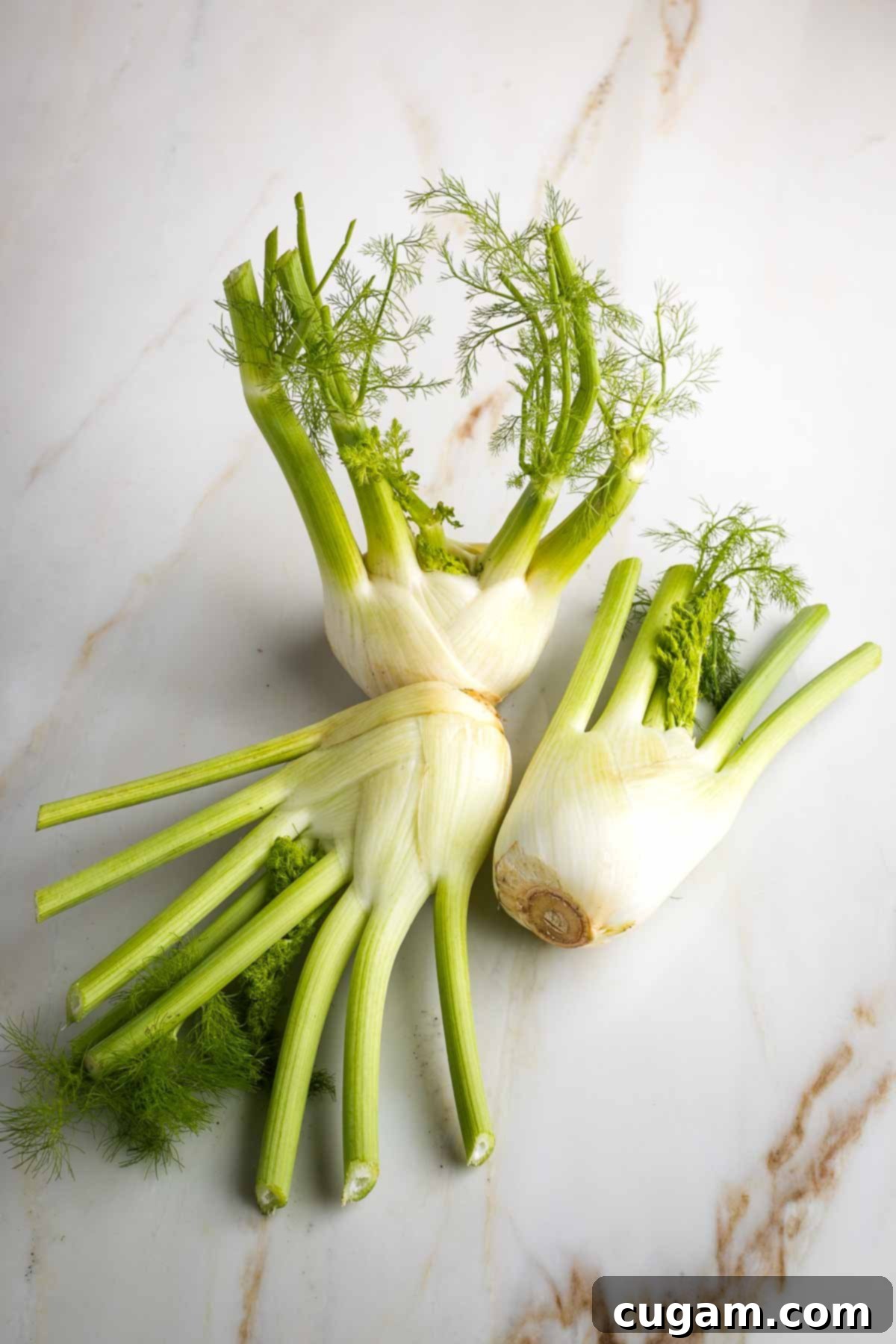
Essential Ingredients & Smart Substitutions for Braised Fennel
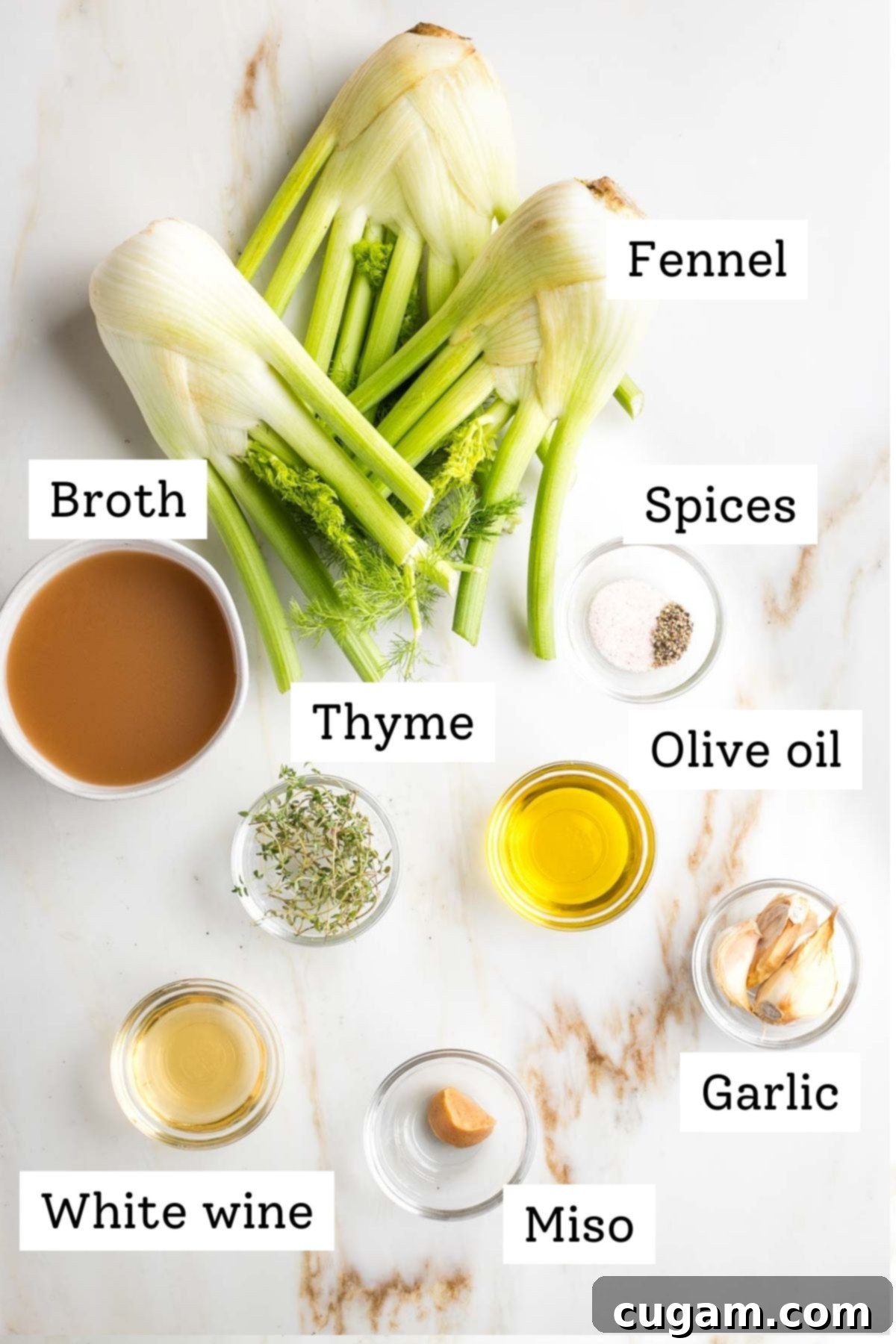
Crafting the perfect braised fennel requires a few key ingredients, but don’t hesitate to experiment with substitutions to tailor the dish to your preferences or what you have on hand. Here’s a breakdown:
- Fennel: The star of our show! When selecting fennel, look for large, firm bulbs with fresh, vibrant green stalks and feathery fronds. Avoid any bulbs with soft spots, browning, or wilting. Remember, the magic of cooking completely transforms its initial anise-like scent into a gentle, sweet, and mild flavor. If you’re looking for a similar braised vegetable experience, thick wedges of sweet onions, leeks, or even celeriac could offer a delightful alternative, though none will replicate fennel’s unique character entirely.
- Broth: The braising liquid is paramount for imparting deep flavor and tenderizing the fennel. I highly recommend using homemade vegetable stock for the richest and most controlled flavor profile. If opting for store-bought broth, always check the sodium content. Many commercial broths are high in salt, so be prepared to significantly reduce or even omit any additional salt in the recipe to prevent over-seasoning. For a non-vegetarian option, good quality chicken broth can also be used, adding another layer of savory depth.
- White Wine: This ingredient adds a crucial layer of acidity, brightness, and complexity to the dish, and is vital for deglazing the pan. Dry white wines like Sauvignon Blanc, Pinot Grigio, or even an unoaked Chardonnay work beautifully. While wine is used, rest assured that the alcohol content will evaporate during cooking, leaving behind only its nuanced flavor. For an alcohol-free alternative, white wine vinegar, apple cider vinegar, or fresh lemon juice are excellent choices. A light lager or pilsner beer can also be a surprising and delicious substitute, offering a unique malty note that complements the fennel.
- Miso: This fermented soybean paste is a secret weapon for adding incredible umami depth, which is especially beneficial in vegetarian dishes where you might otherwise miss the richness often found in meat-based stocks. Light (shiro) miso is generally preferred for its milder, sweeter flavor. If miso isn’t available, a teaspoon of creamy Dijon mustard can provide a similar tang and richness, or a small amount of tomato paste (about a tablespoon) can also deepen the savory notes. Nutritional yeast is another great option for a cheesy, umami boost.
- Herbs and Spices: Fresh herbs truly elevate this dish and infuse it with aromatic goodness. My personal preference is fresh thyme, which complements the delicate sweetness of cooked fennel beautifully. However, fresh oregano or rosemary would also be excellent choices, lending their distinct aromatic notes to the braising liquid. If fresh herbs aren’t available, use about one-third the amount of dried herbs. A bay leaf added to the braising liquid or a pinch of red pepper flakes for a subtle kick can also be wonderful additions to enhance the flavor.
- Olive Oil: A good quality extra virgin olive oil is essential for searing the fennel wedges and building the initial flavor base of the dish. It helps create that desirable golden-brown crust on the fennel before braising, contributing to both texture and taste.
- Garlic: Freshly minced garlic is a non-negotiable aromatic foundation for this recipe. It pairs wonderfully with the fennel and other herbs, creating a rich and fragrant sauce that ties all the flavors together.
Mastering Fennel Preparation: Step-by-Step Guide
Properly preparing fennel is key to unlocking its best flavor and texture. Fennel bulbs can sometimes trap a bit of dirt between their layers, so a thorough cleaning is important. I typically give the outside a quick brush with a vegetable brush or a kitchen-dedicated loofah and then wait to wash it more thoroughly after it’s cut, allowing me to get into all the layers effectively. Follow these simple steps for perfectly prepped fennel:
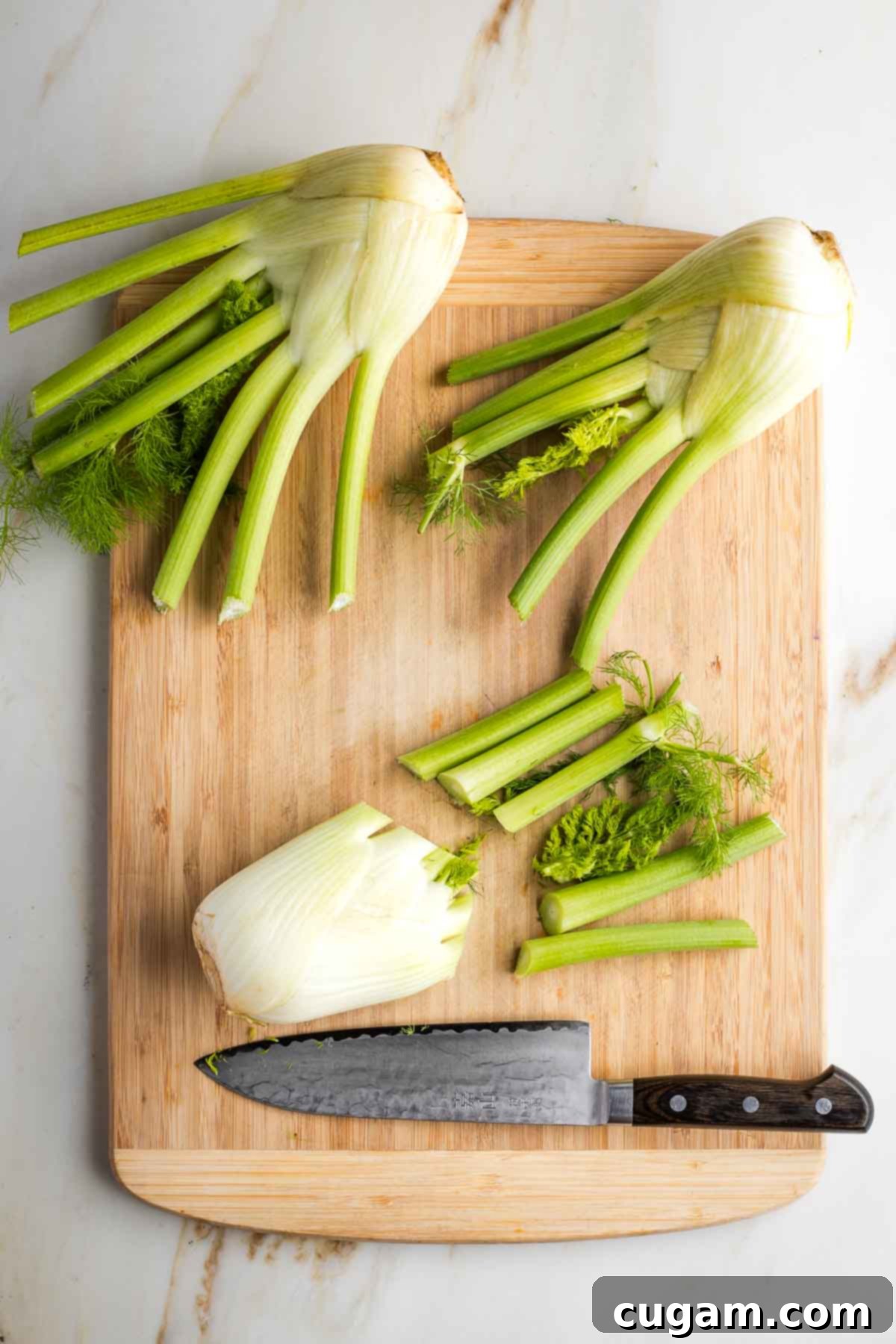
Step 1: Trim the Ends. Begin by cutting a very thin sliver off the root end of the fennel bulb. This removes any dirty or tough bits and creates a clean base. Next, carefully cut off the long green stalks and the delicate, feathery fronds. It’s important to keep these separated, as they will be used later in different parts of the recipe – the stalks for cooking, and the fronds for garnishing.
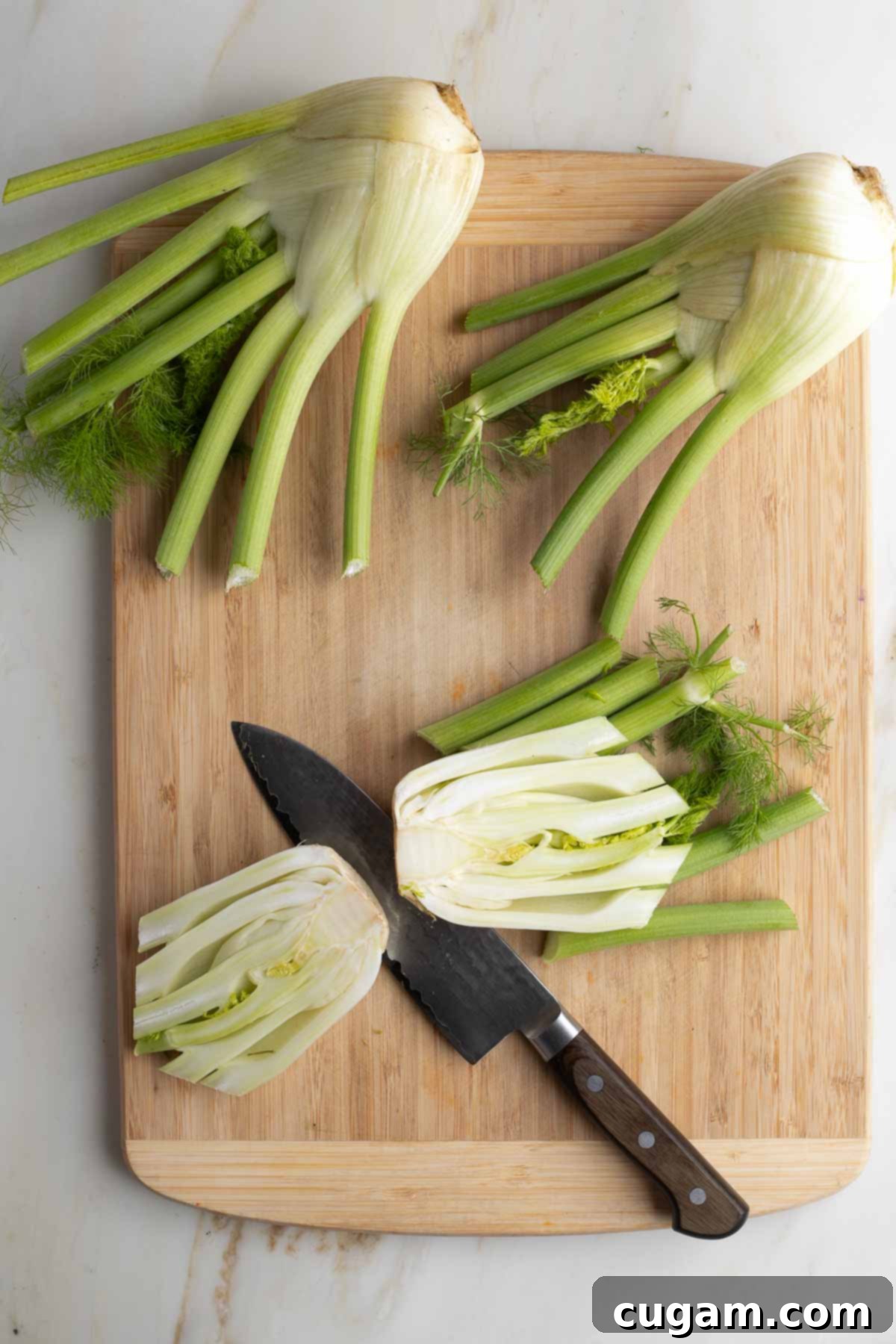
Step 2: Halve the Bulb. Carefully cut each fennel bulb in half, slicing straight down through the center core. This central core is essential for holding the wedges together during the cooking process, ensuring they maintain their shape and don’t fall apart. A sharp chef’s knife will make this step much easier.
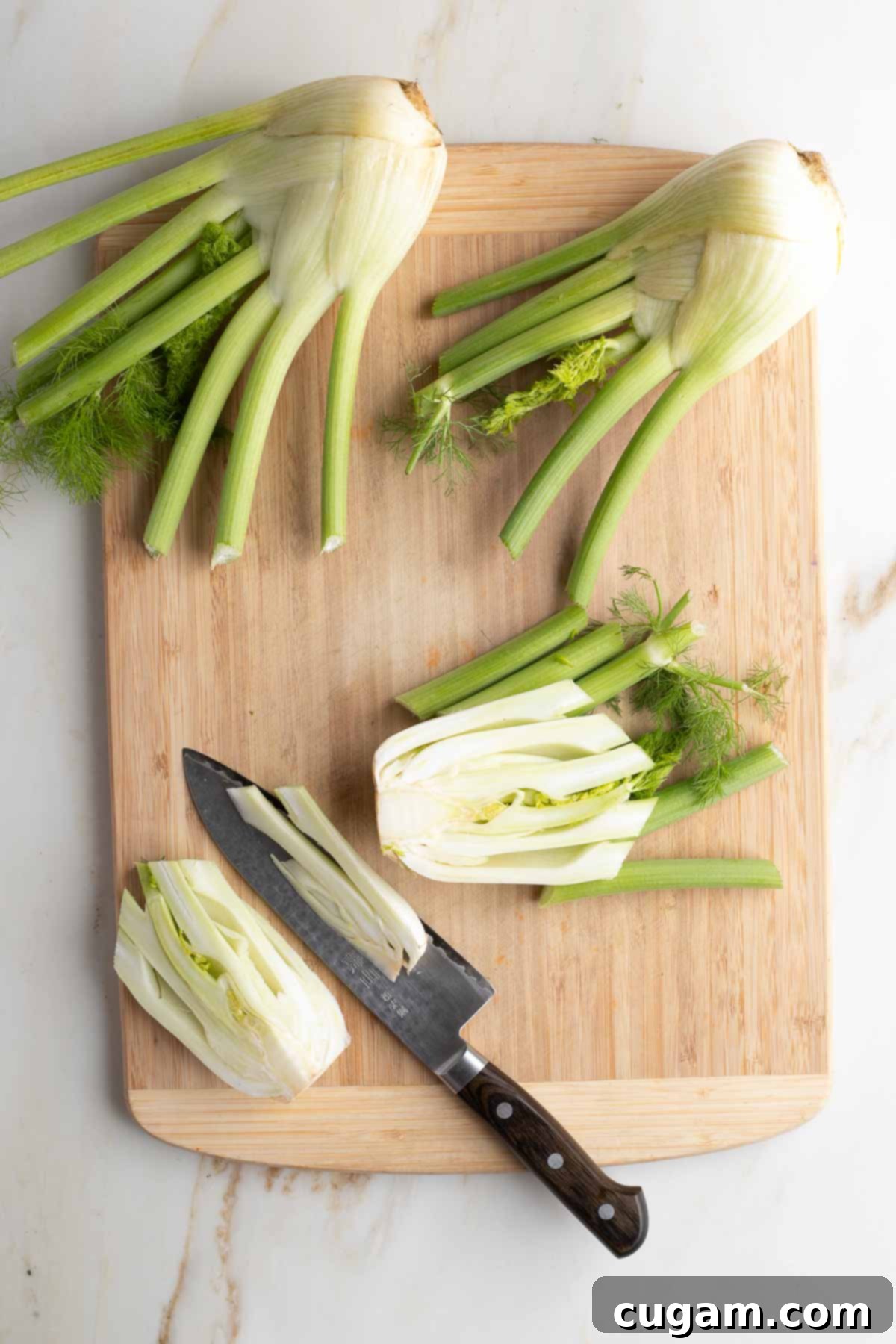
Step 3: Create Wedges. Take each fennel half and cut it into 4-5 wedges, depending on the size of the bulb and your desired serving portion. The crucial part here is to ensure that each wedge retains a small, intact piece of the core. This acts as a natural anchor, preventing the delicate layers from separating and falling apart during the searing and braising steps, keeping your presentation beautiful.
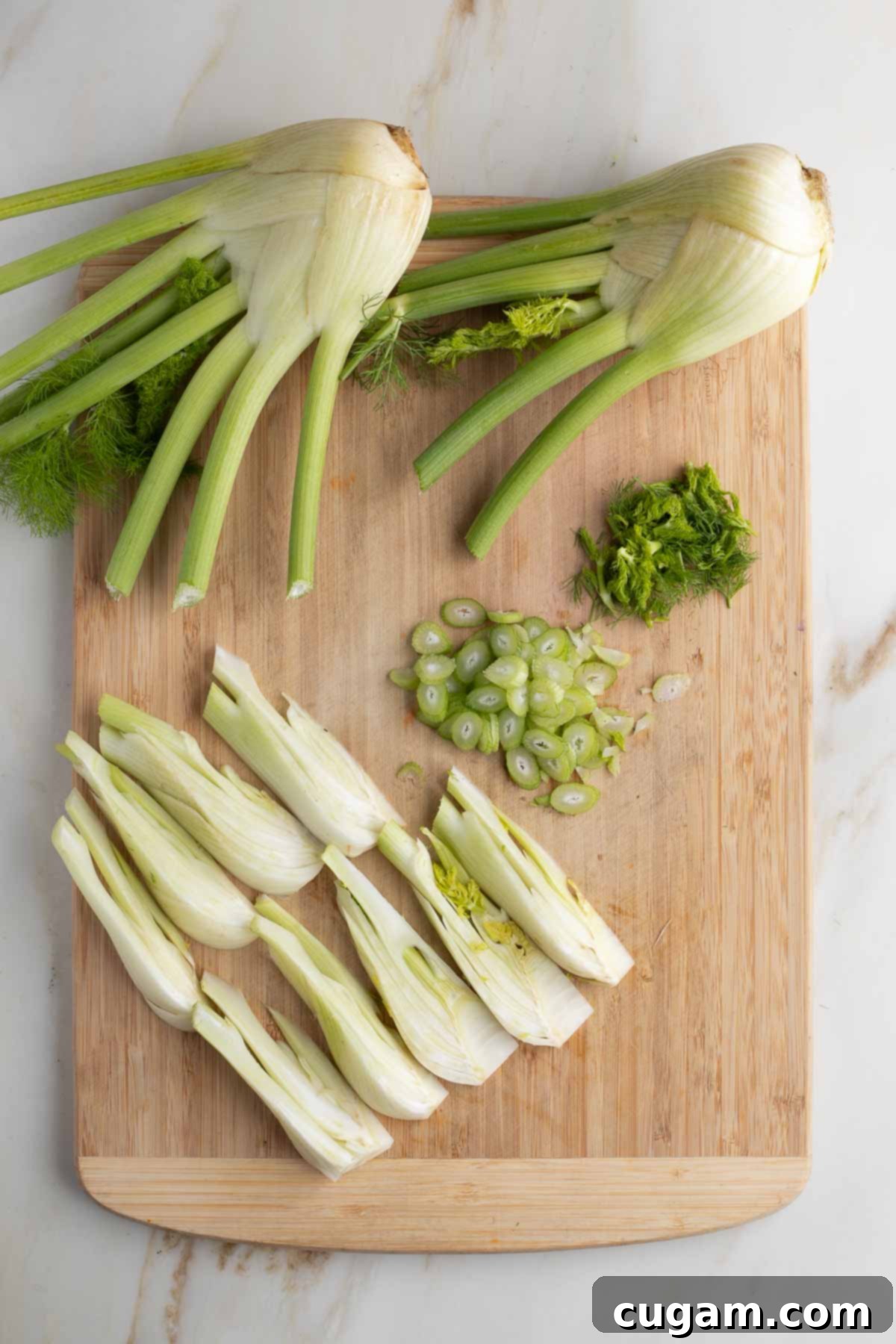
Step 4: Utilize Stalks & Fronds. Never discard these flavorful parts! Thinly slice the lighter-colored, more tender part of the fennel stalks and set them aside. These will be gently sautéed with the garlic to build a robust and aromatic flavor base for your braising liquid. Roughly chop the delicate green fronds, which you previously trimmed, and set them aside as well. They will be used as a beautiful and aromatic garnish just before serving, adding a fresh, subtle anise note and a pop of vibrant color to the finished dish.
Crafting Your Braised Fennel: A Detailed Cooking Guide
Now that your fennel is perfectly prepped, let’s move on to the cooking process. This recipe ensures that each wedge achieves a beautiful caramelization before being lovingly braised to tender perfection. The key is building layers of flavor at each stage, from the initial sear to the rich braising liquid.
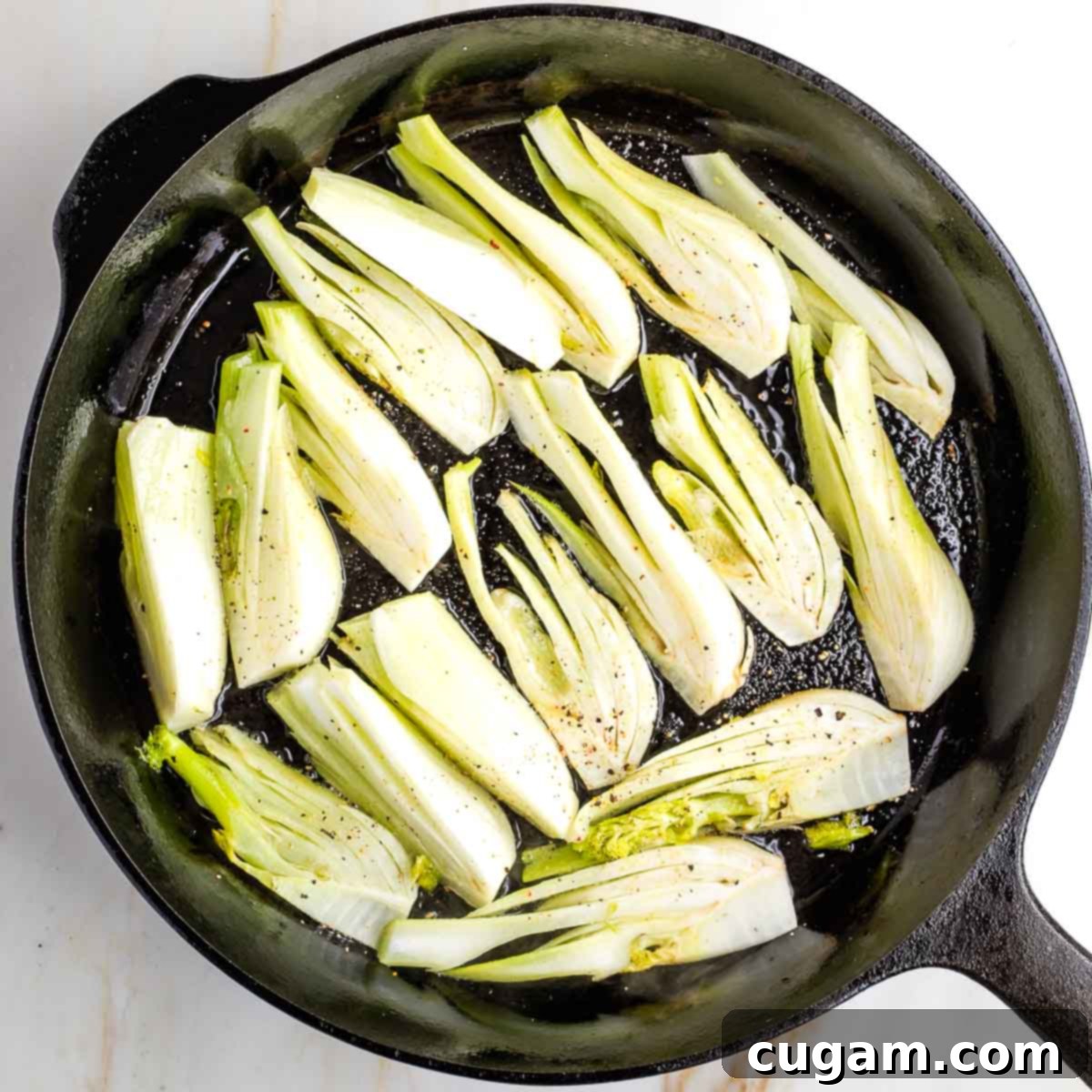
Step 1: Searing the Fennel. Heat a large, heavy-bottomed skillet over medium-high heat. I highly recommend using a cast iron skillet because it conducts and retains heat exceptionally well, ensuring an even and beautiful sear, which is crucial for flavor. Swirl a generous amount of extra virgin olive oil into the hot pan. Arrange your fennel wedges in a single layer, ensuring they have enough space to brown properly without steaming. Depending on the size of your skillet and the amount of fennel, you might need to do this in two batches to avoid overcrowding. Season generously with coarse sea salt and freshly cracked black pepper.
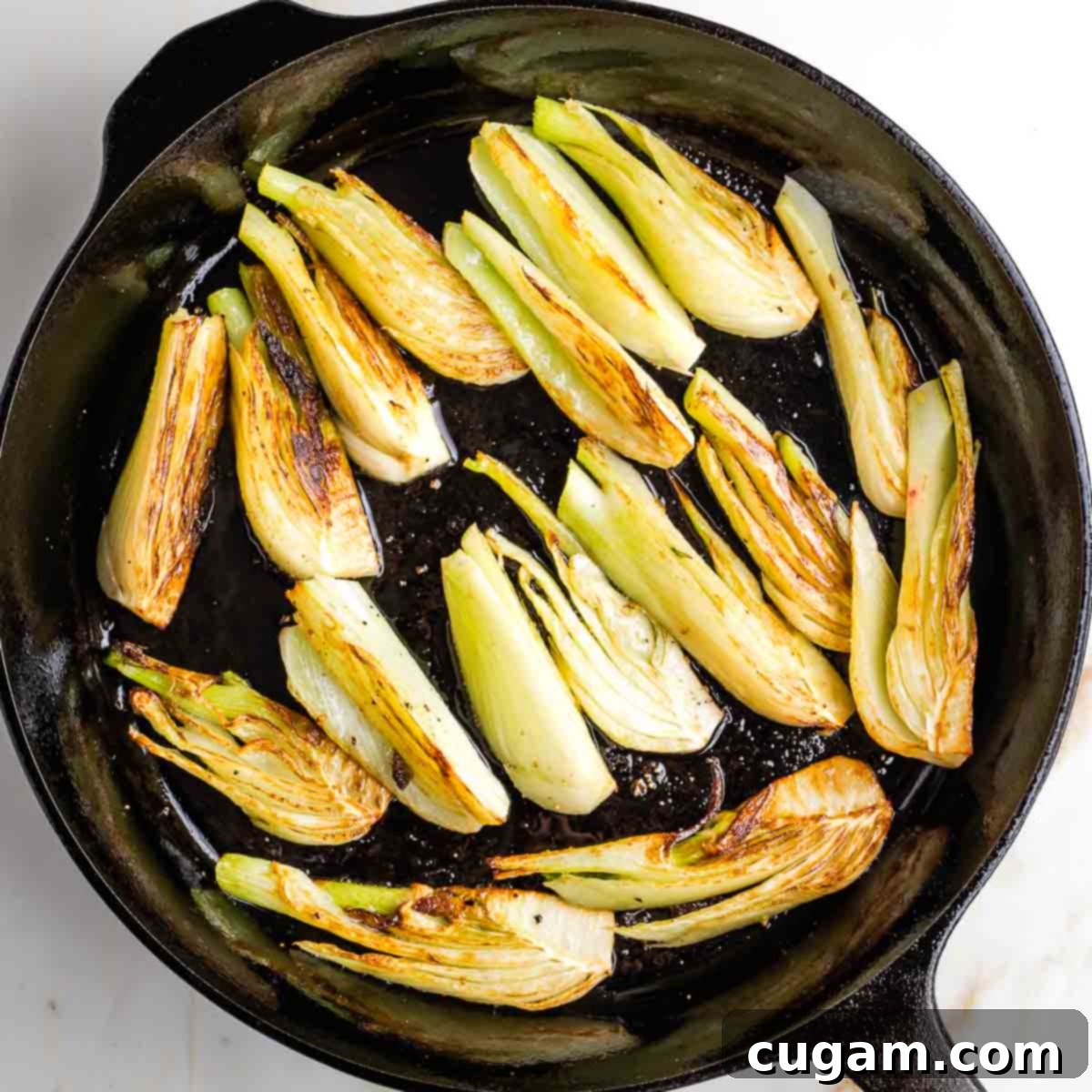
Step 2: Achieve Golden Brown Perfection. Once the fennel wedges are in the hot pan, resist the urge to move them! Allow them to sear undisturbed for a good couple of minutes until the first side develops a beautiful, deep golden-brown crust. This caramelization (the Maillard reaction) is crucial for developing the sweet, complex flavors of the braised fennel. Use tongs to carefully turn each wedge over and repeat the process on the other side, aiming for that same rich, golden color. This initial searing step softens the outer layers and significantly enhances the fennel’s natural sweetness.
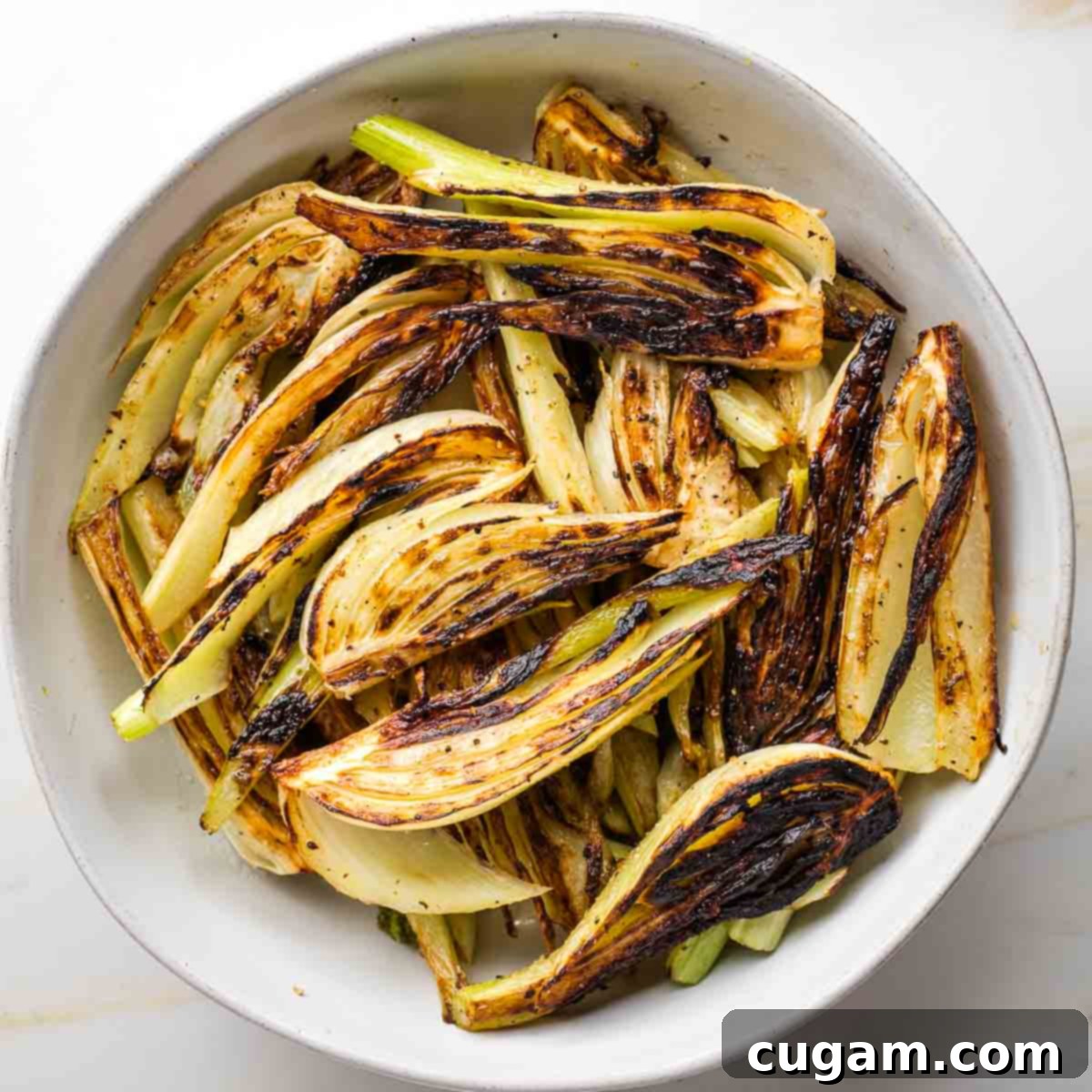
Step 3: Remove and Reserve. As each batch of fennel wedges finishes browning to golden perfection, transfer them to a separate plate or bowl. This allows you to work efficiently and ensures all the fennel gets an even sear without overcrowding the pan. Continue with any remaining fennel until all the wedges have been beautifully browned on both sides. Set them aside for a moment; they’ll return to the pan shortly for the braising stage.
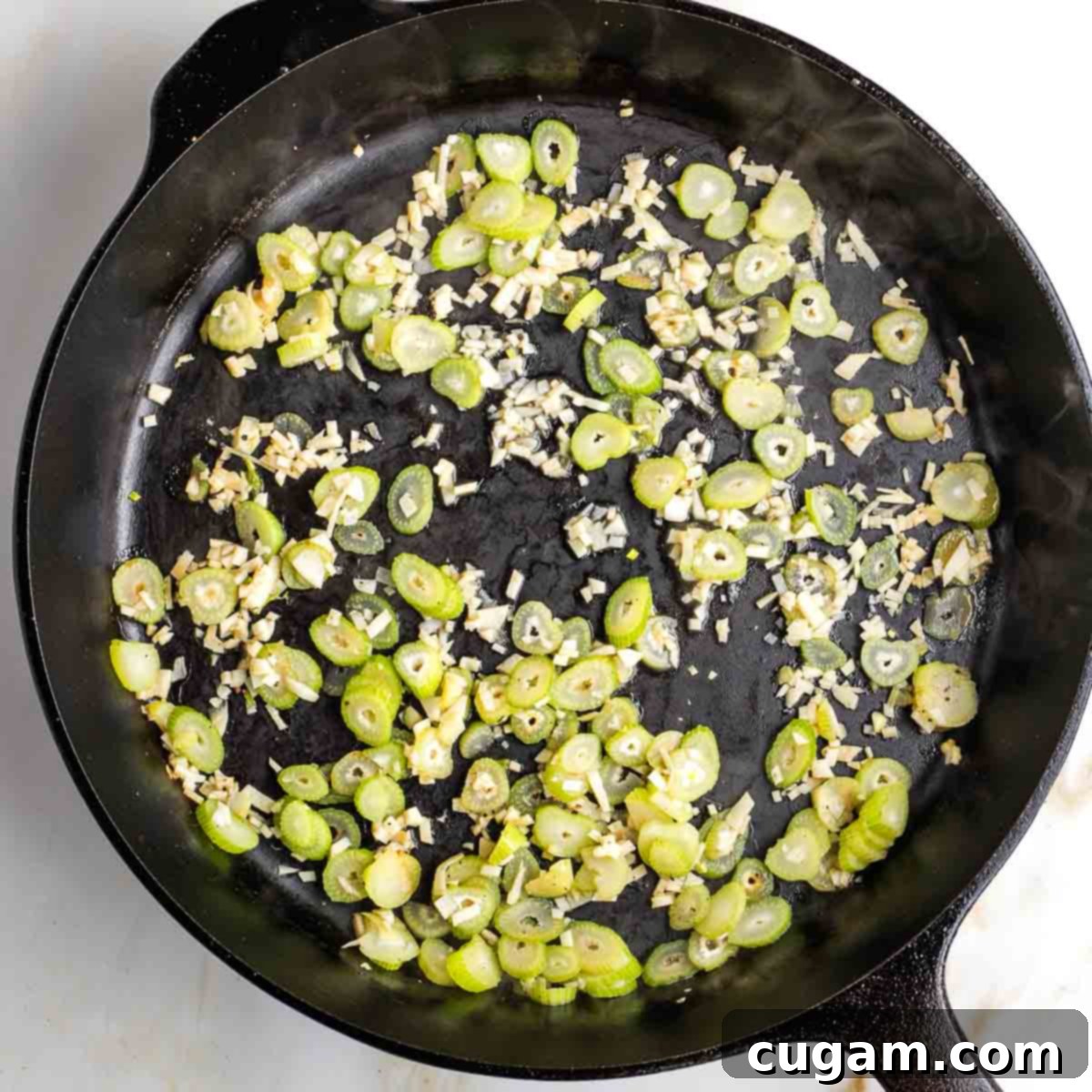
Step 4: Build the Flavor Base. Reduce the heat to medium. Add the minced garlic and the thinly sliced fennel stalks (which you prepared in Step 4 of the preparation section) to the pan. Cook, stirring frequently, until the garlic is wonderfully fragrant and the stalks have softened slightly. This usually takes about 1 minute. Be vigilant not to burn the garlic, as it can quickly turn bitter and affect the flavor of your dish. This step creates an aromatic foundation for the braising liquid.
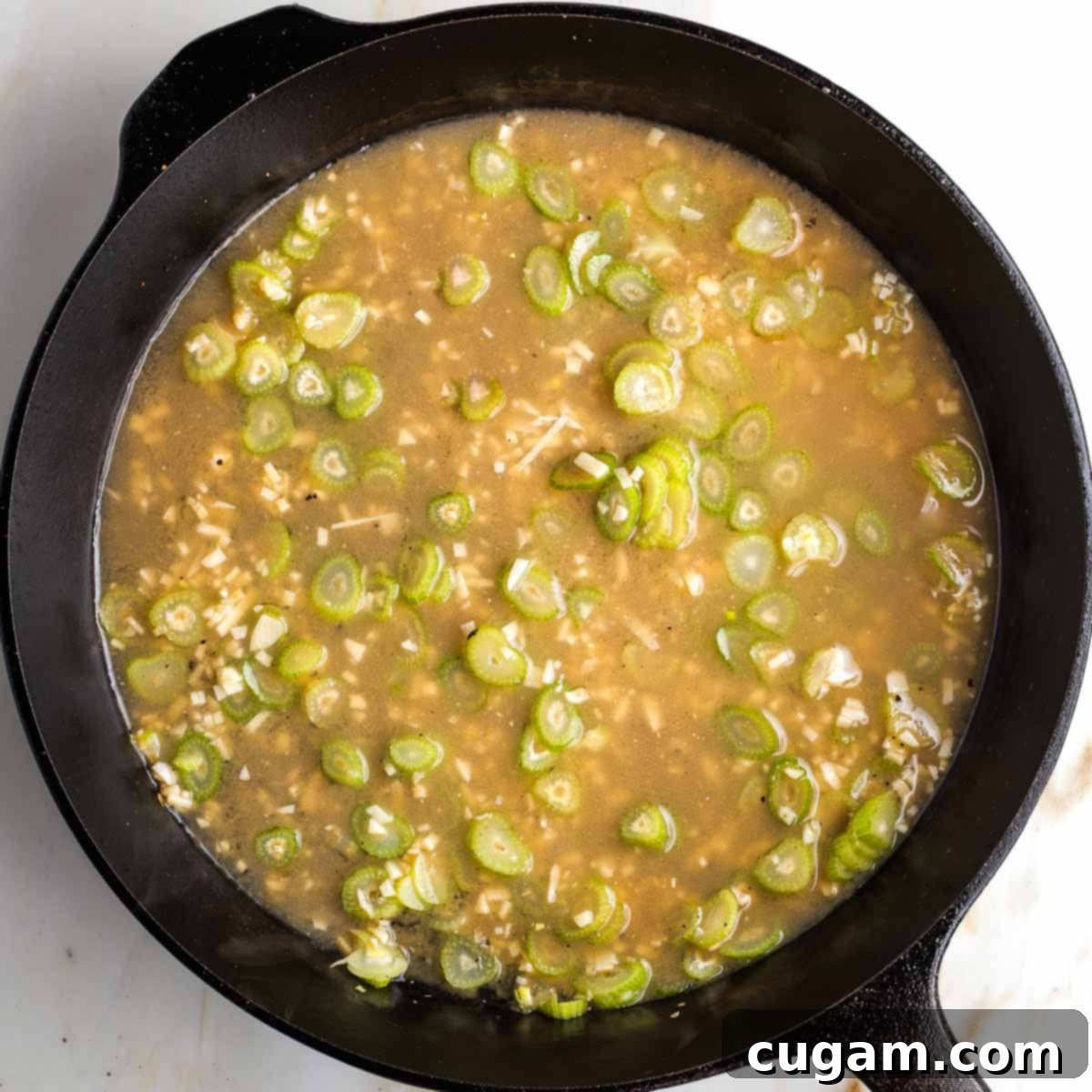
Step 5: Deglaze and Add Liquid. Pour the white wine (or your chosen acidic substitute like white wine vinegar or lemon juice) into the hot pan. Immediately use a wooden spoon or spatula to vigorously scrape up any browned bits stuck to the bottom of the pan. This process, called deglazing, is crucial as it releases incredible, concentrated flavors into your sauce. In a separate small bowl, whisk the light miso paste into the vegetable broth until it is fully dissolved, then pour this flavorful mixture into the pan. Stir everything well to combine the liquid with the aromatics and deglazed bits.
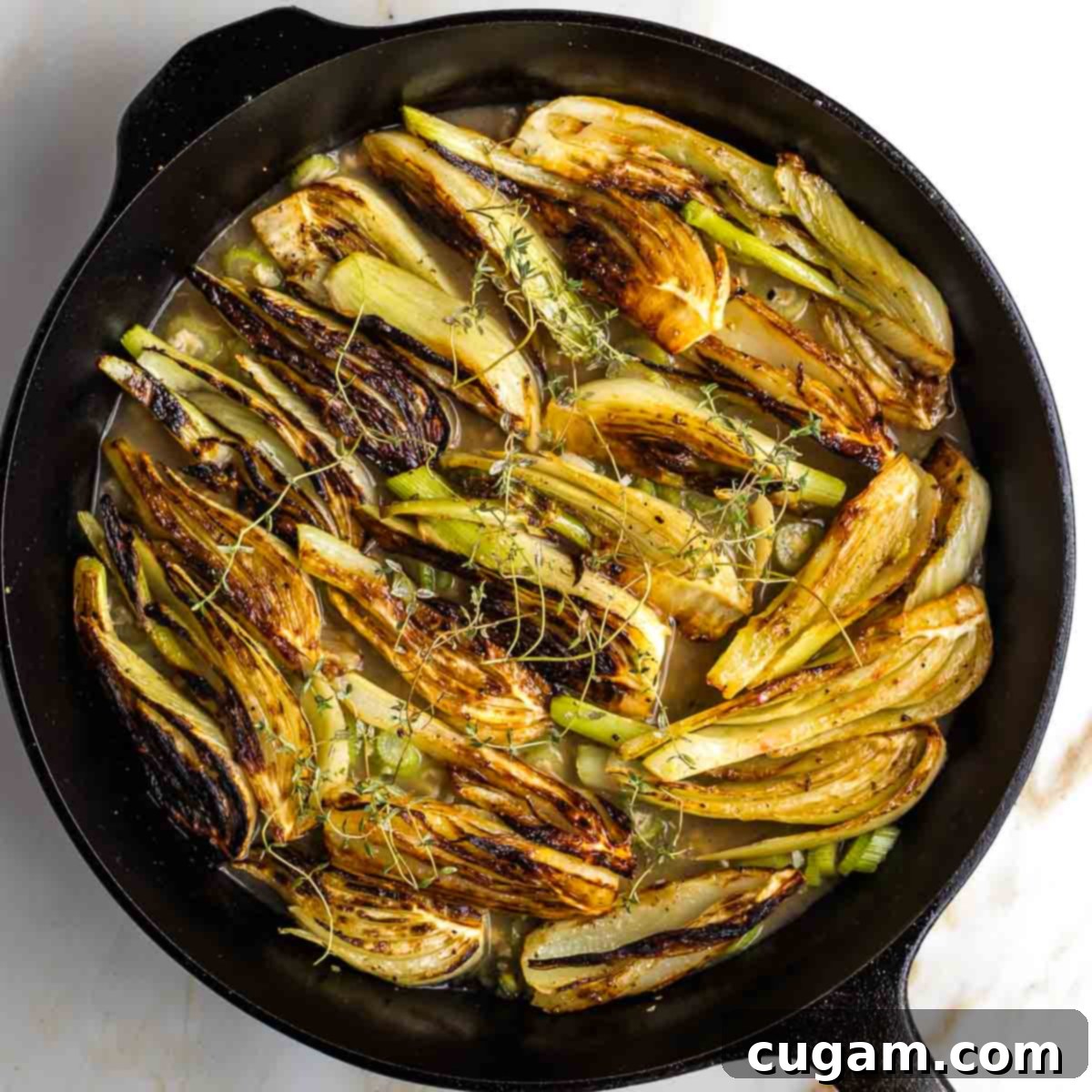
Step 6: Braise to Perfection. Carefully return all the seared fennel wedges to the pan, arranging them over the liquid. You’ll likely find that after searing, the fennel has softened and shrunk slightly, allowing all the wedges to fit comfortably in a single layer now. Ensure there’s enough liquid to partially cover the fennel; if not, add a bit more vegetable broth or water until the desired level is reached. Gently spread the fresh thyme sprigs evenly over the vegetables, allowing their aroma to infuse the dish.
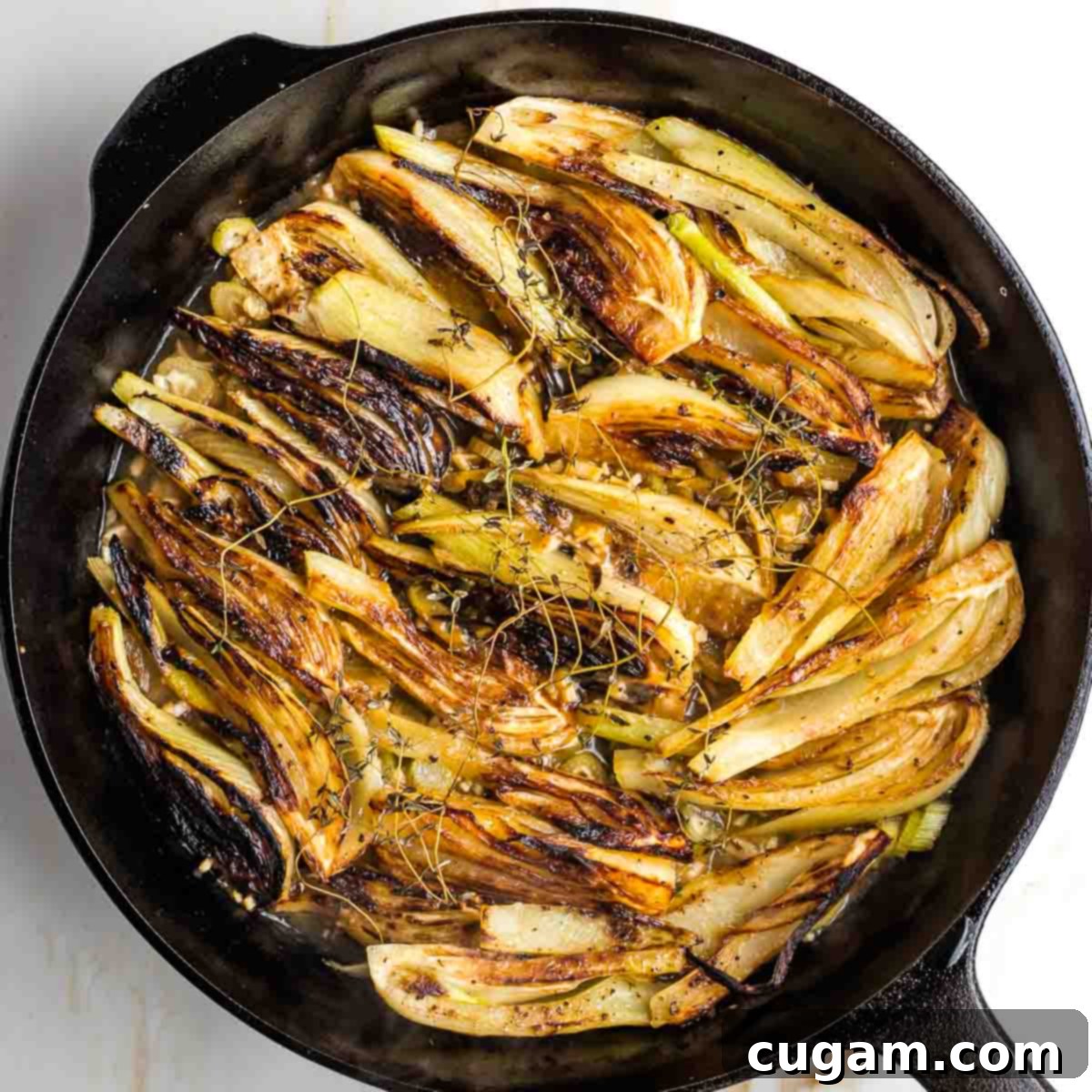
Step 7: Gentle Simmer & Tenderness. Reduce the heat to a gentle low setting, just enough to maintain a steady, consistent simmer beneath the lid. Cover the skillet with a tight-fitting lid to trap the steam and allow the fennel to braise for approximately 20 minutes. Cooking time can vary slightly depending on the thickness of your fennel wedges and your stove’s heat distribution, so check for doneness around the 15-minute mark. The fennel should become incredibly tender when pierced with a fork, with a luscious, caramelized sweetness that is a true testament to the braising process, a far cry from its raw state.
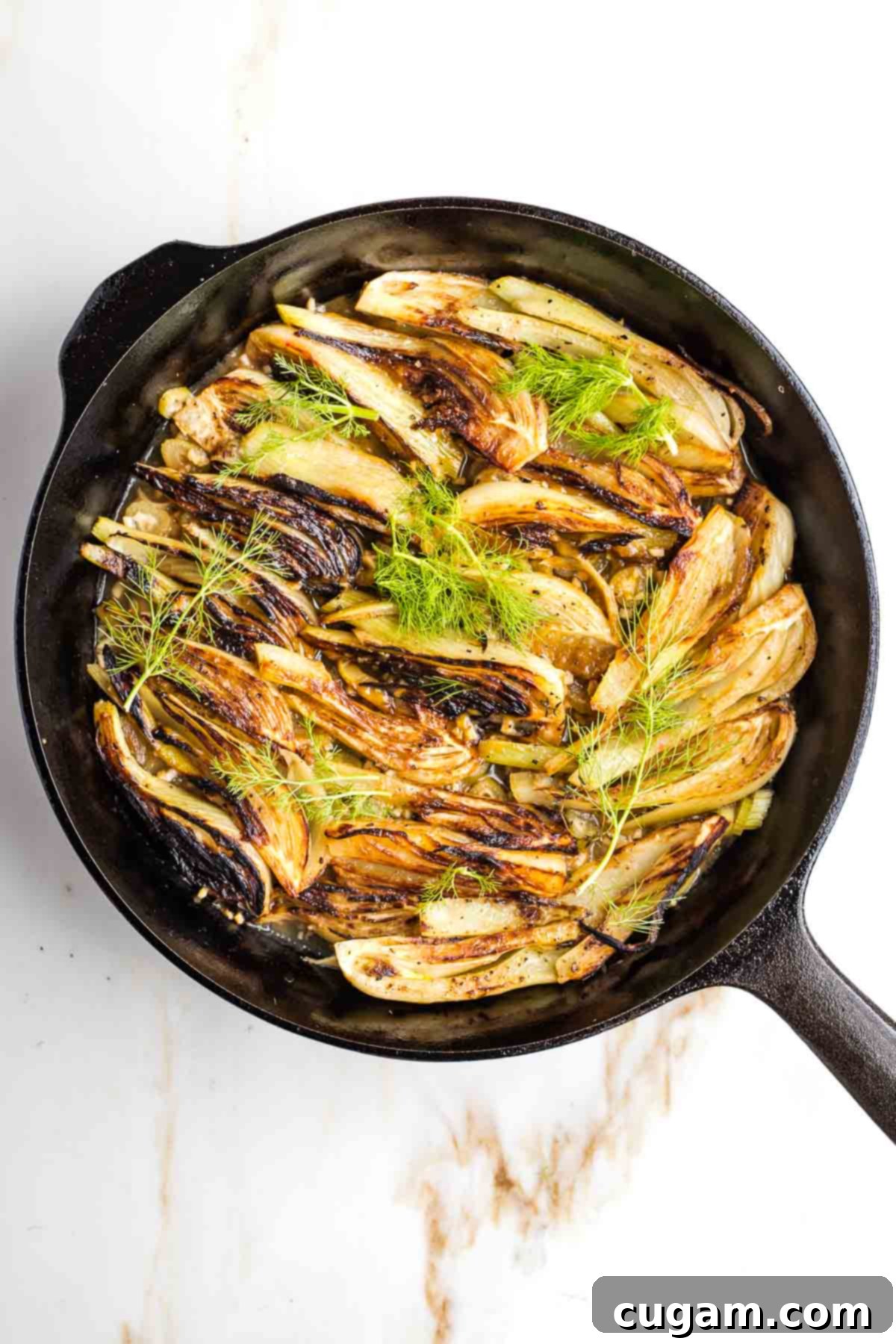
Step 8: Finish and Serve. Once the fennel is perfectly tender, carefully remove the wedges from the skillet using tongs and arrange them elegantly on a serving platter. Leave the pan on the stove for a minute or two to allow the remaining sauce to thicken slightly. If the sauce still seems too thin, you can reduce it further over medium heat, stirring occasionally. Conversely, if it becomes too thick, stir in a touch more broth until it reaches the perfect pourable consistency. Spoon some of the delicious, rich garlic and softened fennel stalks directly over the braised fennel wedges on the platter.
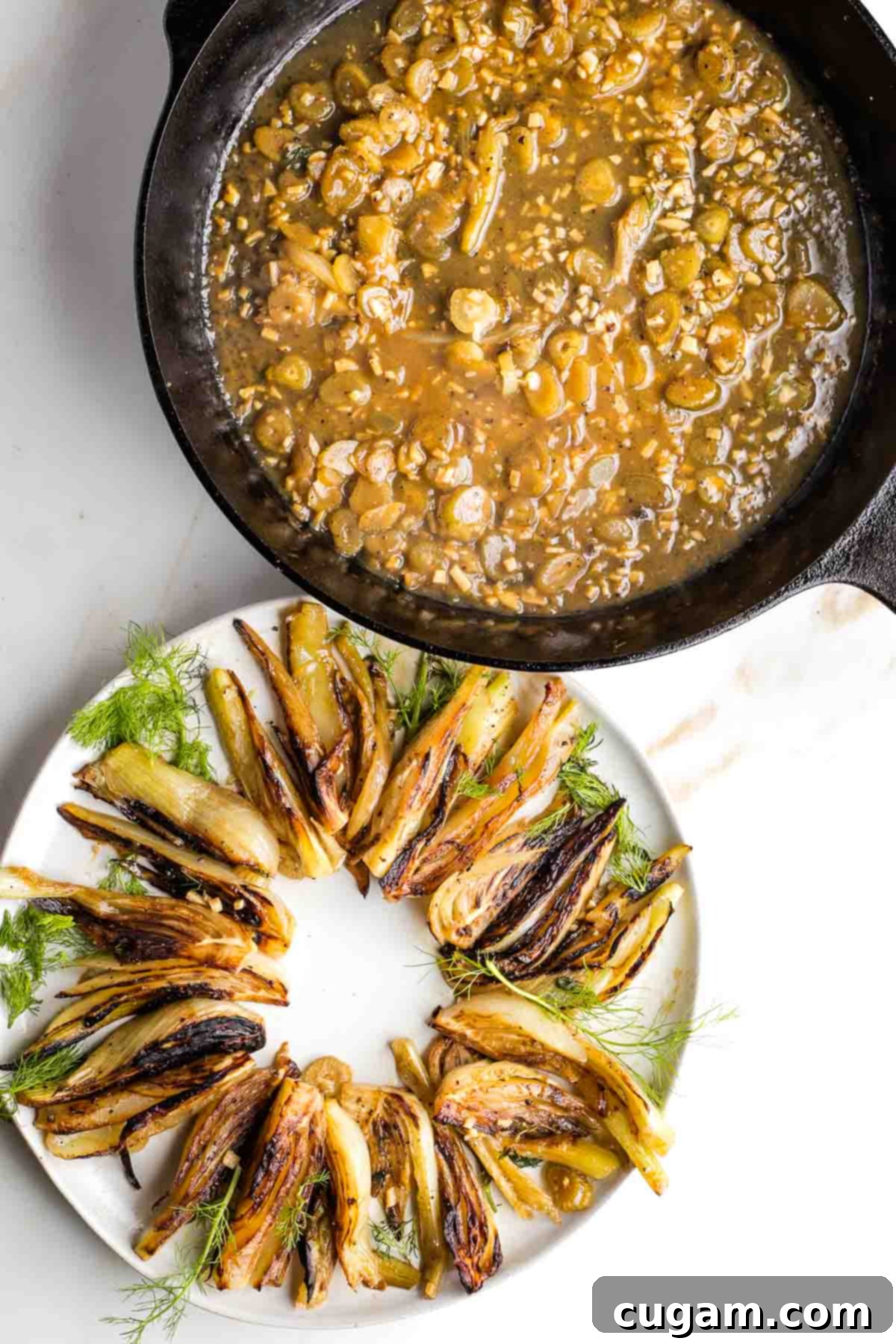
Step 9: Garnish and Enjoy. Drizzle a bit of the savory pan sauce over the fennel on the platter for initial flavor and visual appeal. Serve the remaining sauce separately in a small bowl, allowing individual diners to add as much or as little as they prefer. Garnish generously with the finely chopped fennel fronds and/or a few fresh thyme leaves for a final touch of freshness, aroma, and vibrant color. This dish is incredibly versatile and can be served warm, straight from the pan, or even at room temperature, making it suitable for various occasions.
Debra’s Pro Tips for Perfect Braised Fennel Every Time
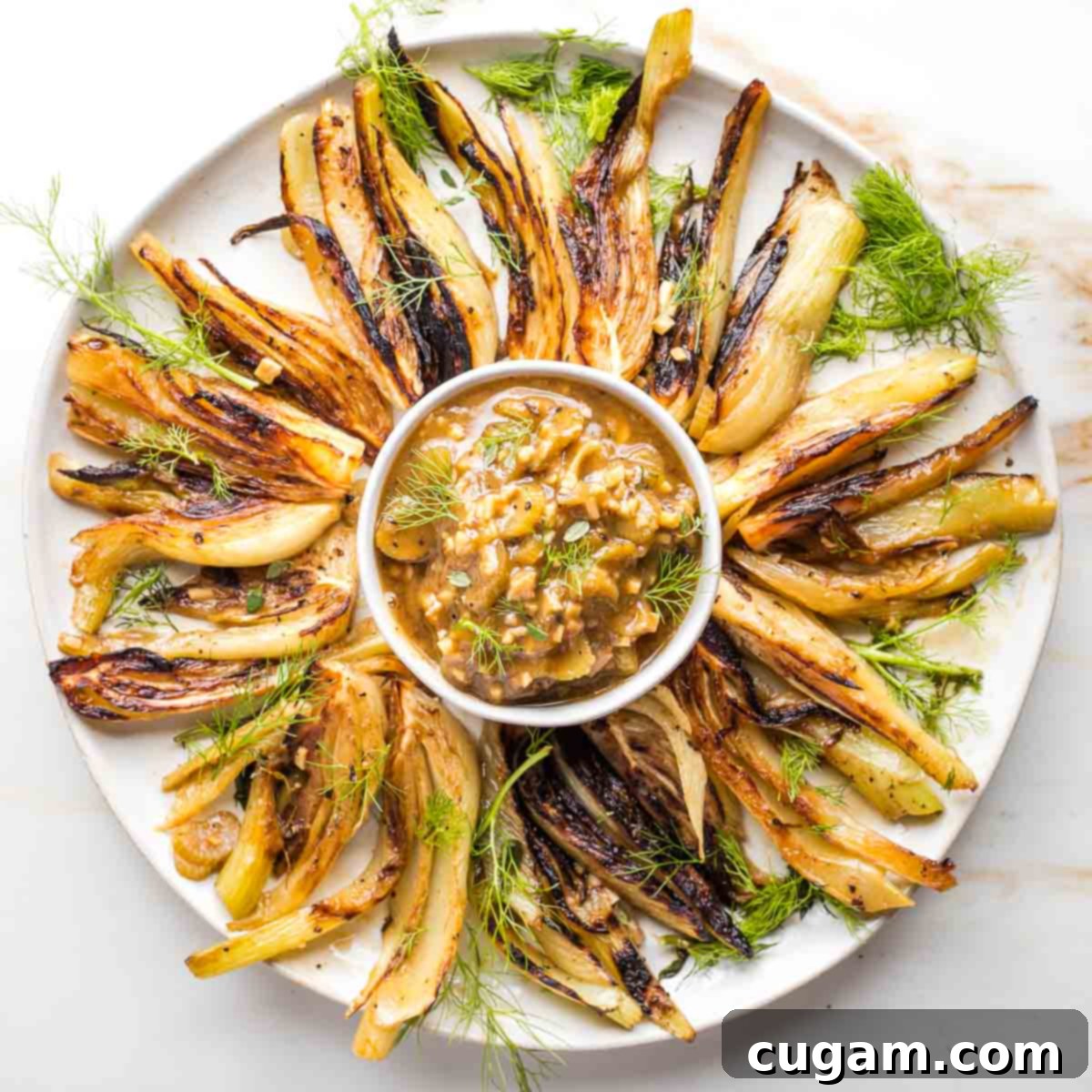
Achieving restaurant-quality braised fennel is easier than you think with these expert tips and tricks:
- Adjusting Sauce Consistency: The perfect sauce can make all the difference. After plating the braised fennel wedges, if the remaining pan sauce seems too thin, simply return the skillet to medium heat and cook for a few minutes, stirring occasionally, until it reduces and thickens to your desired consistency. If, on the other hand, the sauce becomes too thick, whisk in a small amount of additional vegetable broth (about a tablespoon at a time) until it reaches the perfect pourable texture, ensuring it coats the fennel beautifully.
- Thoughtful Sauce Serving: While a light drizzle of the savory sauce over the fennel on the main platter is wonderful for presentation and initial flavor, I highly recommend passing the rest of the pan sauce in a separate small bowl. This approach empowers individual diners to add as much or as little of the rich, aromatic sauce as they prefer, tailoring each bite to their personal taste.
- Fennel Shrinkage is Your Friend: Don’t be alarmed if your fresh fennel bulbs seem too large for your skillet at first glance. As they cook and release moisture during the searing process, the fennel wedges will naturally soften and shrink considerably. This means that even if you initially have to sear them in two batches, they will almost certainly fit comfortably in a single layer in your pan when you return them for the braising step, allowing for even cooking.
- Make Ahead for Stress-Free Meals: Braised fennel is an excellent make-ahead dish, making it perfect for busy weeknights or for entertaining guests without last-minute rush. Prepare the recipe up to 1-2 days in advance. To reheat, simply place the braised fennel in an oven-safe dish, cover it tightly with foil to retain moisture, and warm gently in a 350°F (175°C) oven for about 15-20 minutes, or until heated through. You can also gently reheat it on the stovetop over low heat, adding a splash of broth if needed.
- Convert Licorice Skeptics: For anyone who claims they don’t like fennel because of its perceived licorice flavor, this braised recipe is the ultimate persuader! The high heat of searing followed by the slow, gentle braising process completely transforms the volatile compounds responsible for that strong anise-like taste. What remains is a beautifully mellow, sweet, and earthy flavor with absolutely no hint of licorice. Encourage them to try just one bite – they might just become enthusiastic fennel converts!
- Perfect Pairings for Any Meal: This versatile braised fennel makes a wonderful accompaniment to a wide variety of main courses. Its balanced sweetness and savory notes pair exceptionally well with roasted chicken, grilled or baked fish (especially salmon or cod), succulent pork tenderloin, or even as a flavorful and healthy side for hearty grain bowls or plant-based entrees. Its delicate flavor complements both rich meats and lighter dishes alike.
- Storage & Leftover Brilliance: Store any leftover braised fennel in an airtight container in the refrigerator for up to 3-4 days. It’s delicious cold or gently reheated, making for fantastic packed lunches, a quick addition to salads, or a flavorful component in other meals throughout the week. The flavors often deepen and meld even further overnight!
Did you know commenting and rating recipes is one of the best ways to support your favorite food bloggers? If you made this recipe, please consider a five-star rating below and leave a comment. Also, please share your photos on instagram by tagging me @dkhealthcoach and using the hashtag #debraklein
📖 Recipe
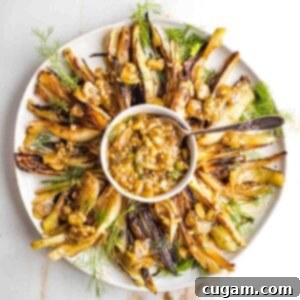
Braised Fennel
Rate this Recipe
Pin Recipe
Equipment
-
12″ Cast Iron Skillet
-
Tongs
Ingredients
- 3 Bulbs Fennel
- 2 tablespoon extra virgin olive oil
- ½ teaspoon coarse sea salt
- ½ tsp black pepper
- 4 cloves garlic minced
- 2 tblsp white wine vinegar
- 1 cup vegetable broth
- 1 teaspoon light miso
- 4-5 fresh thyme sprigs
Instructions
-
Prep Fennel: Cut a very thin sliver off the dirty bottom. Then trim stalks and fronts from the bulb. Thinly slice the lighter part of the stalk and set aside separately from the fronds. Cut each bulb through the center. Then cut each half into wedges with a portion of the core in each wedge to hold it together. You will get 8-10 wedges per bulb, depending on how large they are.
-
Heat large skillet over medium-high heat. Swirl in the olive oil and add fennel wedges in a single layer. You may have to do this in two batches. Sprinkle with salt and pepper. Use tongs to flip after first side is brown, about 2 minutes per side. Transfer to a dish as they’re finished. Continue until all fennel wedges have been seared.
-
Add the garlic and sliced fennel stalks and cook, stirring constantly until garlic is fragrant, about 1 minute. Deglaze the pan with the white wine. Whisk miso into the broth and then add to the pan. Bring to a simmer, while stirring.
-
Return the fennel to the pan, on top of the liquid. There should be enough room for all the fennel in one layer now. Top with thyme sprigs. Turn the heat down to simmer on low, cover and let steam for 20 minutes. Fennel should be super tender when pierced with a fork, sweet and caramelized.
-
Remove fennel wedges to a plate. Leave pan on stove and let sauce thicken for a minute. Spoon a bit sauce over the fennel, and pour the rest into a small dish. Garnish with the fronds and/or some fresh thyme leaves.
Nutrition
Note
The nutrition calculations were done using online tools. To obtain the most accurate representation of the nutritional information in any given recipe, you should calculate the nutritional information with the actual ingredients you used. You are ultimately responsible for ensuring that any nutritional information is accurate, complete and useful.
